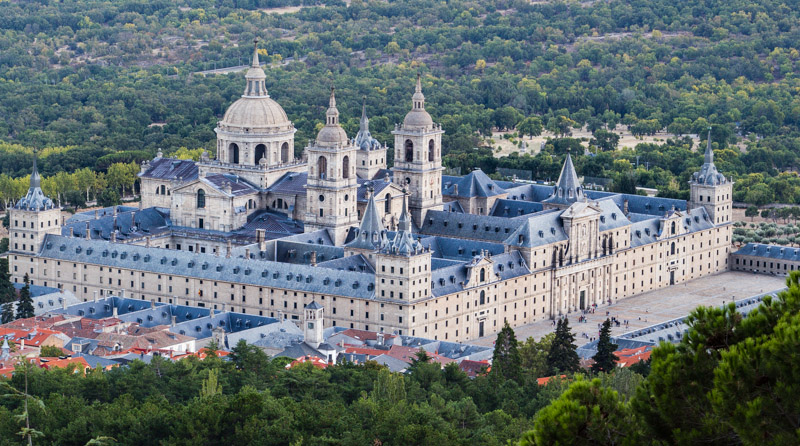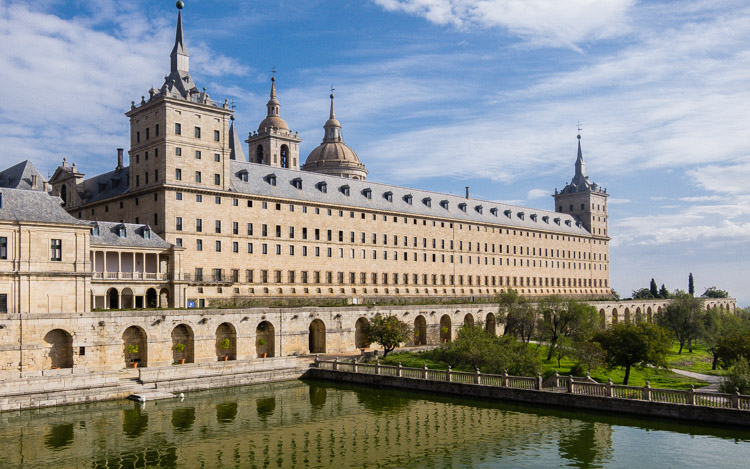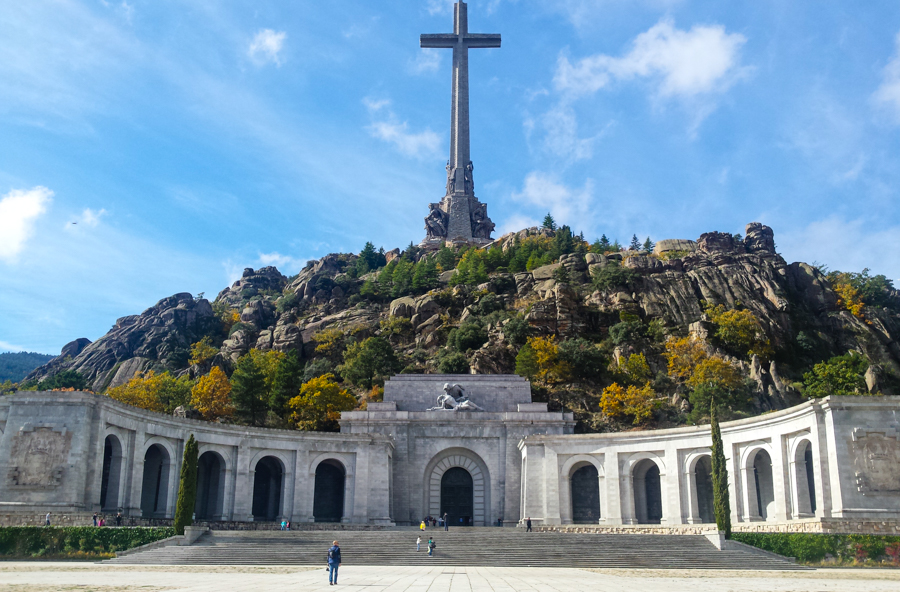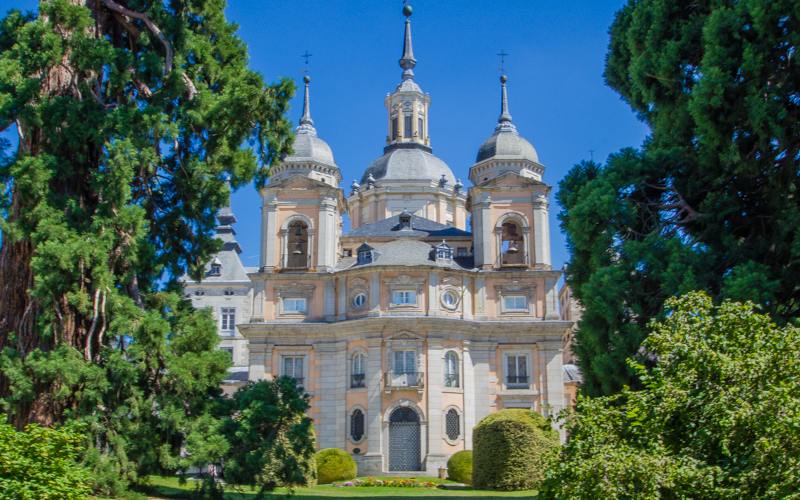Useful Information to visit El Escorial
- El Escorial Monastery and Palace is located in a town called San Lorenzo de El Escorial, 60km from Madrid.
- Entrance fee is 10€
- It opens from Tuesday to Sunday at 10am. Closed on Mondays
- On Sundays there are religious services so is very difficult to see the basilica, is best to avoid this day of the week.
- More details in El Escorial Palace website.
- Photos inside are not allowed
- How to get to El Escorial by bus: Autocares Herranz, lines 664 and 661 from Moncloa (Madrid). It takes around 1h and it cost around 9€ roundtrip.
- How to get to El Escorial by train: Atocha Cercanias line C3 from Atocha, Sol or Chamartin. It takes around 1h and it cost around 8€ roundtrip.
- Send us an email to info@madrisensations.com if you are interested in a private tour from Madrid.
History of El Escorial
El Escorial is both a Palace and a Monastery. It has an immense historical importance, his founder Philippe II, established the capital of Spain in Madrid in 1561. The construction of this Palace was from 1563 until 1584, just a little more than 20 years. The architects where Juan Bautista de Toledo and Juan de Herrera.
After the death of Charles I king of Spain (also known as Charles V as Holy Roman Emperor), there was the urged need of a burial monument for this monarch. So his soon, Philippe II, established here the Royal Mausoleum.
It contains the Pantheon of the kings of Spain. Besides the stunning architecture, El Escorial has many treasures inside, like the library and the collection of paintings.
Is usually accepted that El Escorial was built to commemorate the triumph of the Spanish troops over the French ones in the San Quintin Battle, the 10th of August of 1557, and that day happens to be the festivity of Saint Lawrence, hence the dedication of the monastery to this saint, and the shape of the building as a grill, as this is the symbol of Saint Lawrence and his martyrdom.
What to see in El Escorial
The Escorial has an itinerary that you need to follow, you will see all this:
EXTERNAL FACADES
The main entrance of this massive building is facing the mountains, to the West, and giving its back to the fields and the access from Madrid. It happens to be like this because the church inside has his altar facing East (as all catholic churches do).
The frontispiece is decorated with the coat of arms of the king and an sculpture of Saint Ildefonsus with the grill that represents his martyrdom.
HALL OF BATTLES
This large hall connects the rooms of the King and the ones of the Queen, and it is said that it was used for walks when it was raining outside. The walls are painted simulating tapestries. Pay attention to detail, even the nails and the tassels. On top of the gates the walls are painted as granite stone, extremely realistic!
BEDCHAMBER AND STUDY OF THE QUEEN
The king had 4 wives, and by the time the Palace was finished all of them were already dead, so none of them lived here. Instead one of the king’s daughters, Isabela Clara Eugenia, used this rooms.
LEISURE GALLERY
This Gallery is on the western part of the monument and it gets beautiful views of the fields, it was use for leisure time for the king’s family. It is decorated with paintings and with 51 maps of the 16th century, a detailed atlas of the Spanish Empire, the Empire in which the sun never sets. With territories in Europe, America, Asia and Africa.
ROOM OF PHILLIP II
In this room we see a letter with writings from Philippe II, he was a meticulous bureaucrat. He passed many hours workin here. We can see a clock with an oil lamp, that he used for working during the night. On the walls there are drawings of plants and animals, he was enthusiastic with nature, knowledge and sciences, he created botanical gardens, send expeditions to the Americas to find new medicinal plants.
PANTHEON OF KINGS
This is located right under the Basilica. It is a circular room, with the sepulchres on the walls. Charles V was the first to be buried here, and after him all of the following Kings of Spain. On the left side of the altar, opposite to each king, there are the Queens. But as some kings were married more than once, only the queens who have been mothers of kings were buried here.
PANTHEON OF PRINCES
In the 19th century Elisabeth II decided to create this pantheon for the Royal family members that couldn’t be buried in the Pantheon of kings. There are 9 chambers with many marble sepulchres in each of them.
CHAPTER HOUSE
This halls where made to congregate all the monks of the monastery on a daily basis, usually in order to read or listen to the prior, this is why in the center there is an Eagle stand to hold the gospels. It has an impressive collection of paintings: El Greco, Velazquez, El Bosco, Titian, Tintoretto…
CLOISTER AND PATIO OF THE EVANGELISTS
The most beautiful of the cloisters in El Escorial, it has a small temple in the middle with doric columns on marble. It has the sculptures of the four evangelists and four pounds, representing the four rivers of paradise in the Garden of Eden.
FORMER CHURCH
Or “borrowed church”. This belong to the monastery, which was finished before the rest of the building. So before the Basilica was built, in 1586, this served as the “borrowed church”, and later on it became the chapel of the monastery.
MAIN STAIRWAY
This imperial stairway design by Herrera connected the two cloisters, today we can’t see the upper one because it belongs to the monastery, but we can enjoy the magnificent fresco, painted by Luca Giordano (Lucas Jordan). It depicts the “Glory of the Spanish Monarquy”, with Charles V and Philippe II offering the crown to the Holy Spirit.
BASILICA
The shape of the Escorial Basilica is a Greek Cross, with 50 m each side and huge columns. It creates solemnity and devotion with the massive dimensions and austere ornamentation. The frescoes are by Luca Giordano.
The reliquaries: Philippe II was obsessed with the collection of relics and he was very devoted. He send people all over Europe to collect them and he manage to amass more than 7000 of them. Two cupboards where built on each side of the main altar for them, and we can see them in the Basilica, usually closed. One of them was accessible by a passage to the King’s rooms.
The Altarpiece contains 8 paintings, 15 bronze sculptures and a tabernacle, together in a red marble altarpiece with four levels with Doric, Ionic and Corinthian columns. Design by Juan de Herrera.
Bronze cenotaphs: On the right side there is Philippe II with his family, and on the left side Charles V with his family. All of them are kneeling down looking at the altar, wearing amours and cloaks with their coat of arms.
KING’S COURTYARD
Is the main entrance to the Basilica, and it has its name for the sculptures of the six kings of Judah, from the Old Testament, that are represented here.
EL ESCORIAL LIBRARY
A group of humanists collected books for the king, in order to have all the knowledge of humanity in the King’s library. Also, in 1612, Philippe II created a new law, by which every book published had to send a copy to this library.
Two fires, wars and other events have diminish the original collection, but even so there still are more than 40000 books and manuscripts, written not only in Spanish, but also in Latin, Greek, Armenian, Hebrew, Persian, French, Arabian…
The frescos in the dome are one of the most magnificent sights in El Escorial. They where painted by Tibaldi and it depicts the 7 liberal arts, Philosophy and Theology.
We offer private tours and day trips from Madrid
If you want to visit El Escorial with a tour guide we would be happy to organice a private day trip with pick up at your hotel. You can also make a combination of ‘Madrid & El Escorial’ or ‘Segovia & El Escorial‘. We would arrange transportation and entrances to all monuments.






0 Comments